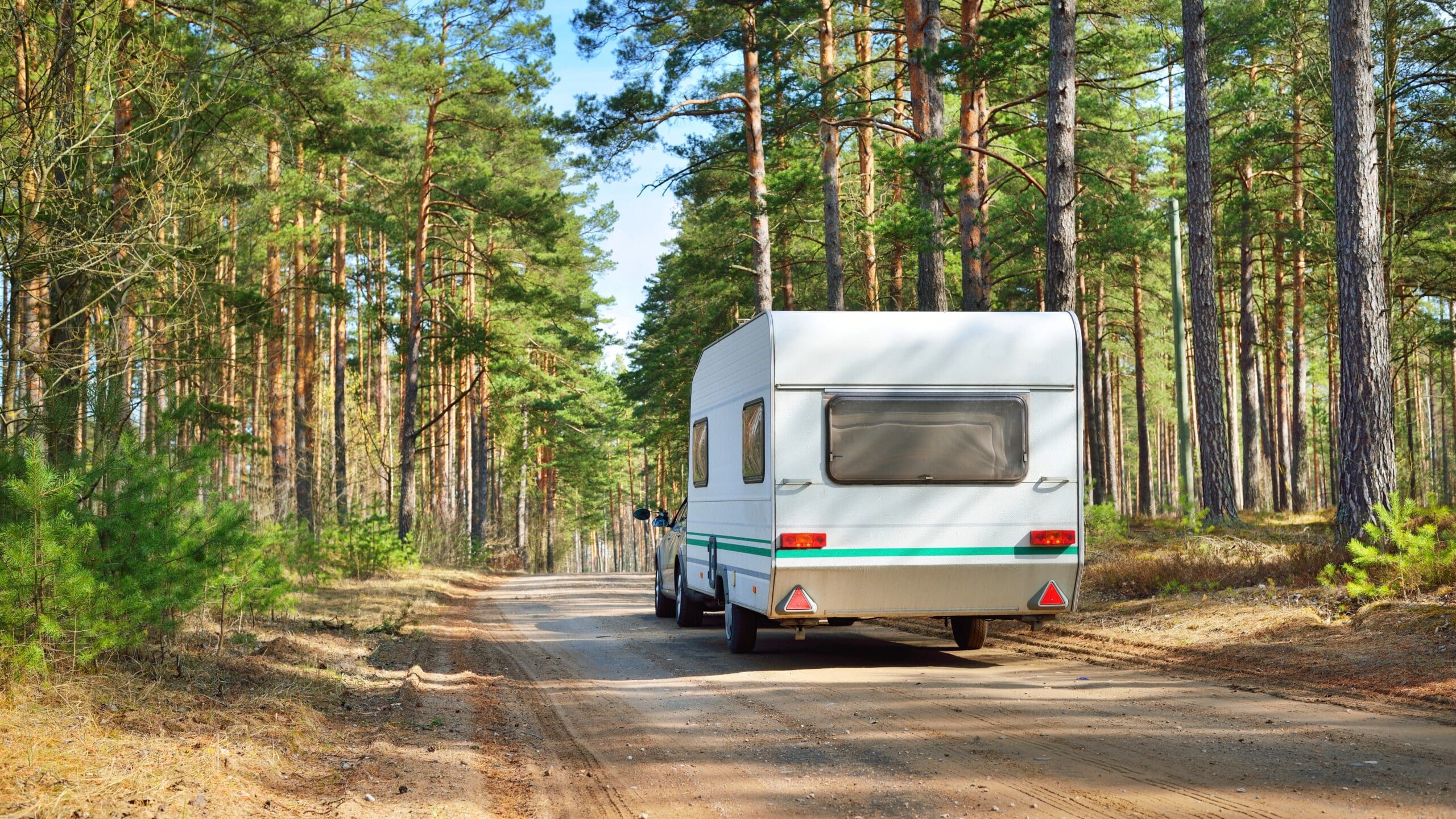5 Reasons Your Caravan Awning Is Leaking & How To Fix It
Some of the links below are affiliate links. As an Amazon Associate, I earn from qualifying purchases. This means that, at zero cost to you, I will earn an affiliate commission if you click through the link and finalize a purchase.
If you live on the road or regularly go on road trips with your caravan, an awning can add much-needed comfort to your travel adventures. It protects from the unpredictable UK weather and offers extra living space outdoors. However, things can get frustrating and complicated fast if a leak occurs.
Your caravan awning can start leaking due to a broken seal, torn fabric, improper pitching, among other reasons. More often than not, you can repair a leak yourself using affordable products from your local caravan accessory store. But in some cases, you may need to buy a new awning.
In this article, we’ll look at the common causes of leaks in caravan awnings and how to fix them. The goal is to help you quickly identify the source of a leak in your caravan awning so you can address the issue promptly and prevent any significant damage.
5 Reasons Your Caravan Awning Is Leaking
- Broken Seal
A broken seal could cause leaks in your caravan, leading to wood rot and mould or mildew growth underneath surfaces. There are a lot of seals on the roof and sides of your caravan—around skylights, windows, vents, compartments, and the perimeter.
Assuming the original seal of your awning rail is damaged. If it starts raining when you’ve put up the awning, you may notice water running down the caravan’s exterior wall, which, in this case, is also the inside of the awning.
A leaking awning rail may be due to the awning pulling the track away from the vehicle, compromising the seal. Regular servicing of your caravan can ensure a broken seal is spotted early, saving you from costly water damage repairs.
- Hole in the Fabric
If you’re using a fabric awning, water could be getting through a hole in the cover or zipper. Holes and tears result from the fabric becoming worn due to different reasons, such as exposure to sun and rain, improper storage, and regular use of the awning.
Examine your awning for any tears in the fabric and address any you find as soon as possible. Even if the tear or hole is small and barely allows any water through, procrastinating fixing it can result in a small hole becoming larger. Then you’ll have a considerable amount of water leaking in.
Fortunately, you can easily and quickly repair holes and tears in the fabric using an awning repair kit. If the poles, which make up the frame (except for inflatable awnings), are bent or broken, they should also be fixed or replaced as they not only compromise your awning’s structural integrity but can also tear the fabric.
If your awning is old and worn out, it may be time to replace it with a brand new one that’s not as vulnerable to fabric and structural damage.
- Awning Doesn’t Fit the Caravan Properly
An awning that’s not a proper fit for your caravan can cause various problems. If too large, you’ll have water pooling on top due to poor tension, resulting in leaks. If too small, you won’t be able to peg out your awning correctly such that it sits tight against your caravan.
So before you purchase an awning, take relevant measurements of your caravan to determine what size awning will be the perfect fit. For a full-sized awning, measure your caravan’s A-measurement, i.e., the distance in centimetres from ground level to ground level through the awning rail.
If you still have your caravan manual, all the dimensions of your caravan, including the A-measurement, will be listed inside. If not, you’ll have to get the measurement yourself, as shown in this YouTube video by IsabellaCamping:
For a porch awning, measure the height from the ground level to the awning rail, then the length along the top of the awning rail. Ensure the door falls within the measured section such that it opens comfortably into the awning. And that a porch awning measuring the length you find wouldn’t obscure any side windows and vents.
- Large Needle Holes Near Stitched Seams
Because the needle used to sew the awning seam is thicker than the cotton passing through the needle holes, water may drip through the holes. This is particularly true of new awnings when subjected to water the first few times.
The holes eventually seal when the wet cotton thread swells and fills the needle holes. However, this process takes time, during which water may leak at the seams.
Additionally, if the cover is stretched too tight along the sewn seam will cause the needle holes to become too large, leading to leaking problems.
- Improper Pitching
If you don’t pitch your caravan awning correctly, water can leak inside when it rains. It could be because the awning isn’t fitting tight on the frame, so water collects on the fabric. On the other hand, if you make it too tight, you’ll put a strain on closed zips, which could cause them to break or separate.
Inflatable awnings, also air awnings, are generally quicker and easier to put up and take down since you can inflate and deflate them in minutes.
Nonetheless, if you are very familiar with traditional pole awnings, putting one up can equally be a breeze. And since it can take far more pumps to put up an inflatable caravan awning than indicated in the manual, putting up poles may be less tasking than manually pumping air.
5 Ways To Fix a Leaking Caravan Awning
- Replace the Seal
The solution to a broken caravan seal is resealing.
To reseal your caravan awning rail, gather the items you’ll need first. These will include a drill driver with a Phillips drill bit, plastic scraper, methylated spirit, clean, dry rag, and sealant.
Next, remove the screws and awning rail. If stuck, use a flat blade to pry it out. Scrape out any remaining sealant from the surface of the caravan. Clean off any sealant residue from the caravan exterior and back of the awning rail using the rag and methylated spirit.
Apply the new sealant on the caravan’s surface and carefully place the awning rail back before screwing it into position. Replace or clean the screw caps before fitting them on the screw heads.
- Patch Up the Hole
How you repair tears and holes in your awning fabric will depend on how small or big they are.
To fix small holes that are barely visible and tears less than 3 ft (91.44 cm), use waterproof repair tape to join the torn fabric. Apply the tape on both sides and press down on any air pockets and bubbles with your thumb to smooth them. Entrapped air reduces the adhesion levels in affected areas.
For large holes that allow easy passage of rain and tears longer than 3 ft (91.44 cm), cut out a patching material that’s 2 inches (5.08 centimetres) wider and longer than the tear or hole. Use waterproof glue to stick the patch to your awning or sew it on. If you use glue, allow it to dry before reinstalling or storing your mended caravan awning for future use.
- Buy a New Awning
If your current awning is not the right size for your caravan, you need a new one. In addition to knowing your caravan’s measurements, there are other equally crucial things worth considering before you buy a replacement—these include:
- When and how often do you plan to use the awning? If, for instance, you plan on caravaning in winter, you need a winter awning that can handle heavy snow. A porch awning is ideal for weekend getaways, while a full-size one is best for longer holidays.
- What will you use the awning for? To sleep and or eat inside your awning, you’ll want one with plenty of room. If just for storage purposes, a small caravan awning will suffice.
- What’s the best fabric for your awning? A strong, durable, and breathable material with insulating properties like vinyl/acrylic-coated polyester is ideal for frequent usage. On the other hand, a lightweight and not so durable fabric like polycotton will do for occasional use.
Tip: Generally, the higher the quality of a caravan awning, the heavier it’s likely to be.
- Allow Thread To Swell To Seal Needle Holes
If your new awning is leaking at the seams, erect it and wet it down thoroughly, both top and bottom, so the thread used for stitching swells and completely seals the needle holes. To prevent creating a mess inside the awning, you can use a spray bottle to wet underneath the seam.
If the awning still leaks, I’d recommend using a seam sealant, which you can buy at a caravan accessory shop or online. Stormseal Seam Sealer on Amazon.co.uk dries clear in minutes and adheres on natural or synthetic fabrics alike. Apply the seam sealant on the inside of the seams using the foam pad that comes with the product.
- Properly Pitch Your Awning
First, read and understand the manual before attempting assembly. Improper pitching can damage the awning and or allow water ingress, ruining your camping trip.
Second, pick the site where you pitch your caravan very carefully. Ideally, the spot should be flat, as fitting an awning correctly on sloped or uneven ground can be a nightmare.
Third, don’t pitch close to water. Not only can water come under your awning, but it can also lead to condensation in your awning. Most people confuse condensation for leakage. So don’t be quick to troubleshoot water inside your caravan awning as a leak—chances are it’s just condensation.
Lastly, ensure proper tension of the poles for maximum strength and stability, particularly in wet and windy weather. If you pitch your awning too tight, the needle holes in sewn seams will enlarge enough to let water in. Poor tension on the flip side results in water pooling on the fabric, causing leaks.
Caravan Planet NZ shows how to correctly pitch a traditional-style full-size awning in the following YouTube video:

